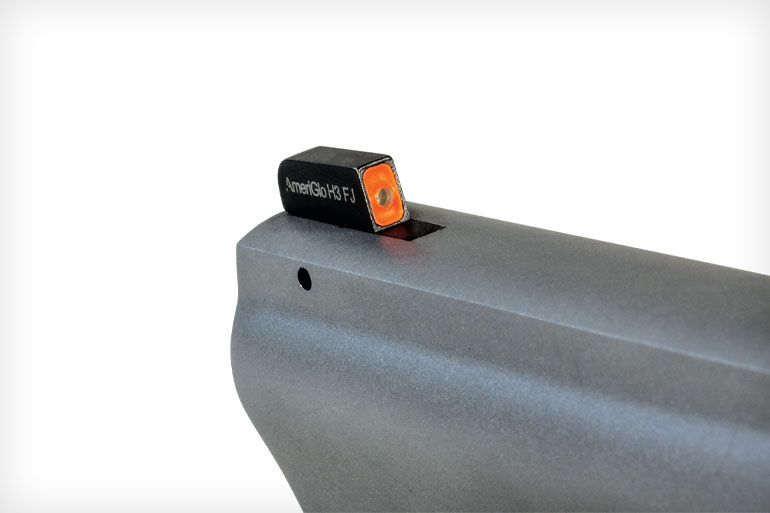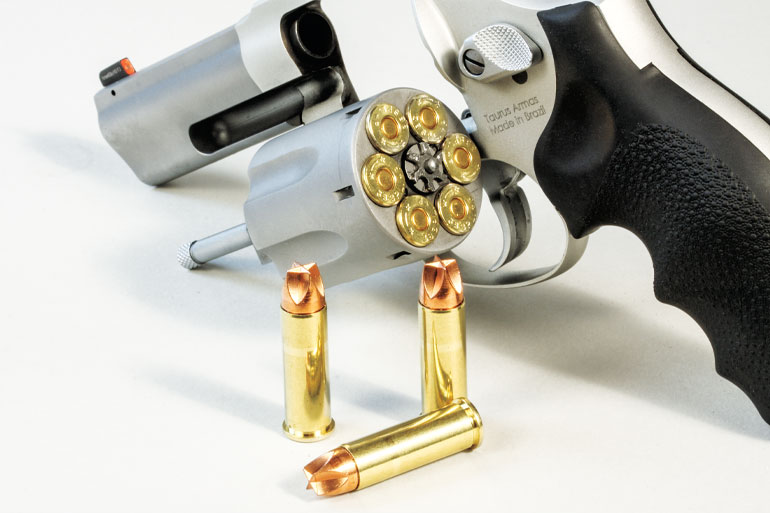About a year ago, I reviewed the 856 Ultra-Lite—a successor to the Model 85 with six shots instead of five—and came away impressed by the inexpensive but good-shooting snubnose revolver. Recently, Taurus came out with a three-inch version, the Defender, and it is equally impressive.
This particular model is an aluminum-framed Ultra-Lite, one of two such guns in the sixgun 856 Defender lineup. These weigh 17.5 ounces, half of what the four all-steel models weigh. Overall length is 7.5 inches, and the width across the fluted steel cylinder is 1.4 inches.
I think the most outstanding feature on the 856 Defender is the front sight. While the rear is simply a gutter milled into the backstrap, the front is a day/night sight, which is not something you expect to find on a revolver with a suggested retail just north of $400. It’s an AmeriGlo, marked “H3 FJ,” for which I could find no details on AmeriGlo’s site. But no matter. It features a bright orange stripe into which a small tritium vial is set. It’s a sight that’s very quick to pick up in any lighting condition. It is pinned in place.

The three-inch barrel is of one piece and fully shrouded. The muzzle sports a slight crown to protect the rifling. It, the crane and the cylinder are matte stainless.
When I posted a range photo of the 856 Defender Ultra-Lite on Facebook, one visitor commented that I must’ve shot the gun really hot because the cylinder was discolored. While some of what he noticed was simply fouling, the gun’s appearance was also due in part to the fact that the steel parts are slightly darker than the anodized finish on the aluminum frame. It’s not quite two-tone, but I think it gives the gun a unique look.
The right side of the frame features the Taurus bull logo and “Taurus Int’l Mfg Miami, FL-USA” along with the serial and model numbers. The left side is stamped “Ultra-Lite” and “Taurus Armas Made in Brazil.”
The cylinder release is nice and big, and it’s serrated so your thumb won’t slip. The exposed hammer’s spur is likewise serrated.
The rubber grips come from Hogue. They have a pebbled texture, finger grooves and a dish at the top where your firing-hand thumb rests. They’re not full wraparounds, so a thin strip of the frame’s backstrap is exposed.

I actually prefer this in handguns that don’t have a lot of recoil because the lack of extra material at the back makes the grip a bit smaller. Even though I have medium-size hands, I almost always find that slimmer, smaller grips shoot better for me.
The trigger is what you’d expect. The double-action pull is relatively smooth, with typical stacking, and it breaks at nine pounds, 14 ounces on average. The single-action pull has a wee bit of creep and grit, and it breaks at three pounds, seven ounces.
I own one revolver with a three-inch barrel, a Ruger GP100 in .44 Special, and I’ve come to appreciate this barrel length. The extra inch of sighting radius over a snubby is a big advantage to my astigmatic eyes. Shooting with bifocals is hell, as some of you know.
The longer tube gives just a bit more weight out front, which tames muzzle rise a bit. The 856 Defender is chambered to .38 Special +P, and I found +P loads to be nicely controllable even though it’s such a light gun.
I thought the gun shot great from the bench. While it’s not apples to apples because I didn’t test the same ammo in both guns, but the longer Defender outdid the standard 856 by about a half-inch on average. And regardless of what ammo I fed it, the Defender acquitted itself really well in defensive-type drills.

The beauty of the snubnose revolver is that it makes a great carry gun for those who prefer revolvers. Yes, the Defender has a longer three-inch barrel, but unless you’re carrying it in a pocket—in a proper pocket holster, of course—the extra length isn’t going to affect concealability. Because it’s a lightweight aluminum frame, you’re bearing hardly any burden in terms of weight.
In the final analysis, I think the 856 Defender has a lot going for it. It has that useful night sight, it doesn’t weigh much, and it’s easier to shoot than a two-inch snubby. Couple that with its $425 suggested retail price, which will bring mid-to-high $300s at dealers, and you’ve got a dependable, shootable and affordable concealed-carry revolver.
Taurus 856 Defender Ultra-Lite Specs
- Type: Single-action/double-action centerfire revolver
- Caliber: .38 Special +P
- Capacity: 6
- Barrel: 3 in.
- OAL/Height/Width: 7.5/5.0/1.4 in.
- Weight: 17.5 oz.
- Construction: Matte stainless barrel, cylinder, crane; anodized aluminum frame
- Sights: Gutter rear, AmeriGlo day/night front
- Trigger: Double action, 9 lb. 14 oz.; single action, 3 lb. 7 oz. (measured)
- Safety: Transfer bar
- Price: $425
- Manufacturer: Taurus, TaurusUSA.com
Taurus 856 Defender Ultra-Lite Accuracy Results
